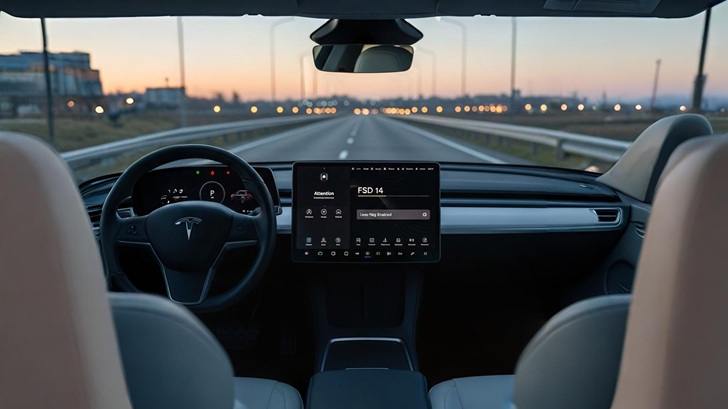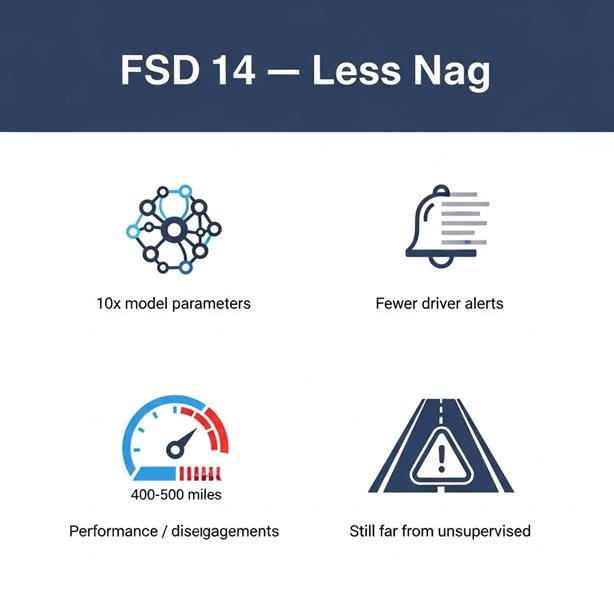Tesla CEO has been stirring the pot again — this time promising the next Full Self-Driving (FSD) update will bring “10x higher parameters” and, intriguingly, “much less nag.” For owners who’ve been waiting years for the company’s self-driving promises to materialize, that sounds like progress. For others — including safety advocates, industry watchers, and cautious drivers — the headline sounds a lot like hype until the hard numbers arrive.

So what does “less nag” actually mean? In Tesla speak, the “nag” is the set of seat‑belt chimes, steering reminders, and attention alerts that keep drivers engaged while Autopilot or FSD is active. Tesla’s rules are clear: drivers must remain attentive and are ultimately responsible for the car when using these systems. Cutting back on alerts could make for a more pleasant ride, but it also risks letting drivers get complacent — and that’s precisely the concern critics raise.
The “10x higher parameters” line refers to neural network size — basically, how big and complex the underlying AI model is. A larger model can have more capacity to learn patterns from data, which sounds promising. But bigger models aren’t a magic bullet. Real-world safety depends on quality training data, robust validation, and lots of real-world testing. Past increases in model size didn’t translate into tenfold gains in safety or autonomy; the best available evidence shows earlier large jumps produced roughly modest, incremental benefits — on the order of two- or threefold improvements in some metrics.
Which brings us to the most important metric: how far a car can go between “critical disengagements” — moments when the human driver must take over to prevent danger. Public and independent data suggest current top-tier systems see roughly 400–500 miles between such events in favorable conditions. Even if Tesla doubles or triples that figure with the next software release, we’re still far from the kind of reliability that would justify unsupervised driving across all real-world situations.

To put it bluntly: to go from a few hundred miles to truly unsupervised operation would likely require improvements measured in dozens — if not hundreds — of times today’s performance. Industry observers estimate a minimum of a 50x improvement in miles between disengagements would be needed to even approach unsupervised operation in consumer cars, and ideally much more. That’s a steep climb, not a single sprint.
There’s another angle to consider: money. Tesla sells FSD as a package, and unlocking new capabilities can alter how revenue is recognized on the books. A high-profile software release that demonstrably improves performance could let the company recognize deferred revenue tied to sales of the FSD package. That doesn’t mean the update is just an accounting trick, but it does explain why timing and public announcements matter — and why Tesla has a strong incentive to show measurable progress.
Safety and regulatory scrutiny add more complexity. Regulators, insurers, and safety groups are paying attention. A system that reduces driver alerts without demonstrable safety gains could prompt tougher oversight. After all, the goal isn’t comfort; it’s proven safety. The difference between “fewer nags” and “safer roads” is where most of the debate lives.

What drivers and potential buyers should take away from the latest buzz? Be hopeful — incremental improvements in AI and software could make driving easier and safer over time. But be skeptical of marketing shorthand. “10x parameters” sounds flashy, but the public needs independent data: validated disengagement metrics, third‑party testing, and transparent safety reports. The best measure of progress won’t be a tweet or a bold claim; it’ll be real-world performance verified by neutral parties.
If you already own Tesla’s FSD, you’re likely itching for better performance and fewer interruptions. That’s perfectly understandable. But the responsible move is to keep expectations grounded and remain the attentive driver the system expects you to be. For everyone else watching from the sidelines, the next update will be another data point in a long and complicated race toward true autonomy. The promise is exciting, but the road to unsupervised driving remains long — and it’s paved with proof, not just promises.
Related Post
